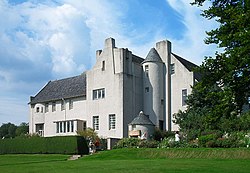Hill House, Helensburgh
| Hill House, Helensburgh | |
|
| |
|---|---|

| |
| Grid reference: | NS299839 |
| Location: | 56°1’4"N, 4°43’47"W |
| Information | |
| Website: | Hill House, Helensburgh |
Hill House is a house in Helensburgh in Dunbartonshire. It is owned by the National Trust for Scotland.
Hill House is one of Charles Rennie Mackintosh's most famous works, probably second only to Glasgow School of Art. It was designed and built for the publisher Walter Blackie in 1902 – 1904.
In addition to the house itself, Mackintosh also designed most of the interior rooms, furniture and other fixings. Mackintosh's attention to detail even extended to prescribing the colour of cut flowers that the Blackies might place on a table in the living room, so as not to clash with the rest of the decoration.
In 1982 the house was donated to the National Trust for Scotland which continues to maintain it and manage visitors. The top floor is leased to the Landmark Trust and is used as holiday accommodation.[1]
The client
To the west of Glasgow, Helensburgh was the new settlement area for those whose business wealth came from the crowded, industrialised city. In 1902, the publisher Walter Blackie purchased a lot in the neighbourhood. After a suggestion from the friend Talwin Morris, Mackintosh was appointed to design and build the future home of the Blackie’s family: The Hill House. At first Walter was surprised with the youthfulness of the architect, until he visited one of the houses Mackintosh had previously designed and was convinced that this was the right person to build his home. Although a few restrictions were still imposed by the owner: no bricks and plaster and wood beams construction, and no red-tiled roof, as would be familiar in Dunbartonshire. Instead, Blackie asked for grey rough cast for the walls, and slate for the roof; and that any architectural effect sought to be secured by the massing of the parts rather than by adventitious ornaments. The few requirements and the non-traditional, ornamental taste of the client himself allowed Mackintosh to give full life to his design ideas.
Prior to start creating an elevation drawing or even a floor plan, Mackintosh spent a few days in the former house of the Blackies to observe their everyday life; to build from the inside out. By profoundly analysing the family’s habits Mackintosh would be able to design every aspect of the house according to the needs of each user. He believed the functional issues should firstly be solved to then let the beauty aspect evolve from the solution. The result could only be one of an extremely satisfied client:
to larder, kitchen, laundry etc he gave minute attention to fit them for practical needs, and always pleasingly designed. Every detail, inside as well as outside, received his careful, I might say loving, attention.
Mackintosh believed this was the only honest way of designing.
The house is reportedly haunted and a staff member described a tall slender figure dressed in black with a long black cape that appeared from Mr Blackie's Dressing Room. Upon entering the White Bedroom the figure vanished.[2][3]
The exterior
The uniform and greyish exterior treatment of the building blends in with the cold cloudy sky of Scotland. The completely asymmetrical construction forms different roof levels and shapes, and also records Mackintosh’s appreciation for A W N Pugin’s picturesque utility where the exterior contour evolves from the interior planning. The minimum decoration, heavy walls, and rectangular and square windows express a strong, sober construction. The exterior qualities of the building are nearly the opposite of the warm, exotic, carefully decorated and smooth interior. Again, Mackintosh relates to Pugin’s theory by minimizing exterior decoration to emphasize the interior design: the transition from the outside world into a safe, fantastic inside space. Paint analysis of the harling on the exterior shows that it might have been left as an unpainted pale grey initially.[4]
The interior
The mansion combined the Edwardian period’s traditional ‘femininity’ of an intimate, inside space, with the ‘masculinity’ of the exterior public world, both uncommonly used throughout the interior of the building. To Mackintosh, bringing the masculine aspects to the inside would break away from the over decorated, entirely feminine conventional interiors. This allowed him to convey different feelings and experiences depending on the purpose of each space. Mackintosh used different materials, colours and lighting, when necessary to perform a full experiential transition from one point to another. All in such an elegant and well planned manner, that with the absence of one the other would mar.
Outside links
- Hill House, Helensburgh - National Trust for Scotland
- www.greatbuildings.com with some exterior and interior photographs
References
- ↑ "NTS Places to visit - The Hill House - Holiday Accommodation". National Trust for Scotland. http://www.nts.org.uk/Property/The-Hill-House/Holiday-Accommodation/. Retrieved 2011-06-20.
- ↑ National Trust for Scotland - Autumn
- ↑ NTS Places to visit - The Hill House
- ↑ Patrick Baty. The Hill House. A report following an examination of a number of external surfaces.11 May 2005.
